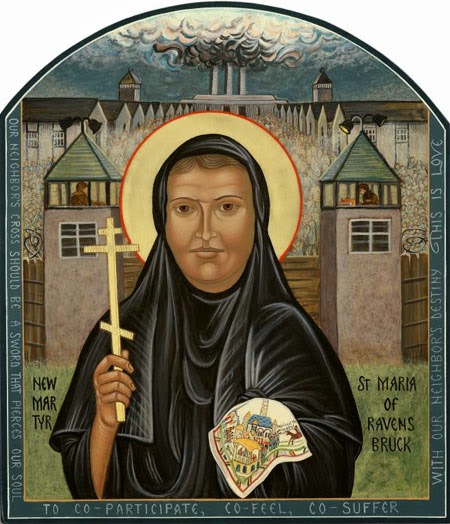Today and next week I will present two modern women who suffered greatly due to the crises of WWII. One defended the Jews and the other was Jewish. ST. MARIA SKOBTSOVA (1891-1945), known asMOTHER MARIA of PARISwas a Russian noblewoman, poet, nun, and member of the French Resistance during World War II. She has been canonized a saint in the Eastern Orthodox Church.
She was born (Elizaveta) to an aristocratic family in Riga, Latvia, then part of the Russian Empire. Her father died when she was a teenager, and she embraced atheism. In 1906 her mother moved the family to St. Petersburg, where she became involved in radical intellectual circles. In 1910 she married an Old Bolshevik by the name of Dmitriy Kuz'min-Karavaev. During this period of her life she was actively involved in literary circles and wrote poetry. By 1913 her marriage to Dimitriy had ended.
Through a look at the humanity of Christ, she began to be drawn back into Christianity. She moved with her daughter, Gaiana, to the south of Russia where her religious devotion increased.
Furious at Leon Trotsky for closing the Socialist-Revolutionary Party Congress, she planned his assassination, but was dissuaded by colleagues, who sent her to Anapa. In 1918, after the Bolshevik Revolution, she was elected deputy mayor of Anapa in Southern Russia. When the anti-communist White Army took control of Anapa, the mayor fled and she became mayor of the town. The White Army put her on trial for being a Bolshevik. However, the judge was a former teacher of hers and she was acquitted. Soon the two fell in love and were married.
Soon afterwards the political tide was turning again. In order to avoid danger, she, Daniel, Gaiana, and her mother fled the country. Elizaveta was pregnant with her second child. They traveled first to Georgia (where her son Yuri was born) and then to Yugoslavia (where her daughter Anastasia was born). Finally they arrived in Paris in 1923. Soon Elizaveta was dedicating herself to theological studies and social work.
In 1926, Anastasia died of influenza. Gaiana was sent away to Belgium to boarding school. Daniel and Elizaveta's marriage was falling apart. Yuri ended up living with Daniel, and Elizaveta moved into central Paris to work more directly with those who were most in need.
Her bishop encouraged her to take vows as a nun, something she did only with the assurance that she would not have to live in a monastery, secluded from the world. In 1932, with Daniel permission, an ecclesiastical divorce was granted and she took monastic vows. In religion she took the name Maria.
Mother Maria made a rented her "convent" in Paris It was a place with an open door for refugees, the needy and the lonely. It also soon became a center for intellectual and theological discussion. In Mother Maria these two elements, service to the poor and theology, went hand-in-hand.
After the Fall of France in 1940, Jews began approaching the house asking for baptismal certificates, which the chaplain, Father Dimitri, would provide them. Many Jews came to stay with them. They provided shelter and helped many to flee the country. Eventually the house was closed down. Mother Maria, Fr. Dimitri, Yuri and Sophia were all arrested by the Gestapo. Fr. Dimitri and Yuri both died at the Dora concentration camp.
Mother Maria was sent to the Ravensbrück concentration camp. On Holy Saturday, 1945, she took the place of a Jewish woman who was going to be sent to the Gas Chamber, and died in her place. (Just like St. Maxmillian Kolbe)
In July, 1942, when the order requiring Jews to wear the yellow star was published, she wrote a poem entitled "Israel":
Two triangles, a star,
The shield of King David, our forefather.
This is election, not offense.
The great path and not an evil.
Once more in a term fulfilled,
Once more roars the trumpet of the end;
And the fate of a great people
Once more is by the prophet proclaimed.
Thou art persecuted again, O Israel,
But what can human malice mean to thee,
who have heard the thunder from Sinai?


